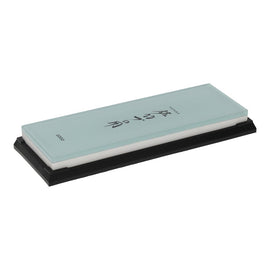
















A whetstone sharpens a knife and keeps it sharp. A whetstone, also called a whetstone , is a professional and refined way to sharpen your knives. It's one of the oldest methods of knife sharpening and is often used on professional chef's knives and Japanese knives. Sharpening with a whetstone is therefore a centuries-old practice, and it still works best. Knives become truly razor-sharp again.
Sharpening stones come in different types. What distinguishes them is the grit size, ranging from a small, fine grit to a large, coarse grit. KookGigant sharpening stones come in five sizes with different grit sizes. Coarse grits are used for blunt knives, while fine grits are used to keep a knife sharp. The type of sharpening stone you need depends entirely on the condition of your knife. KookGigant sharpening stones are double-sided, meaning they have two different grit sizes. Choose the right grit for your knife:
| Grit 200-600 | Restoring a Really Dull Knife |
| Grit 800-1000 | Sharpening relatively blunt knives |
| Grit 2000-3000 | Sharpening normal relatively sharp knives |
| Grit 3000-8000 | Sharpens/polishes razor blades |
A sharpening stone for chef's knives originated in Japan. Japanese chefs have used sharpening stones there for centuries. The reason is simple: a Japanese sharpening stone delivers the best results. It's the perfect way to get your chef's knife razor-sharp and chop your ingredients without resistance.
A whetstone offers the most control while sharpening. This control is important for the longevity of your chef's knives. Every time you sharpen a knife, you remove a layer of steel from the blade. The whetstone gives you control over the angle and the amount of pressure you apply. The more often you sharpen, the sooner your knife becomes unusable. If you maintain your chef's knives properly, you only need to use a whetstone once or twice a year. Naturally, you'll use a whetstone with the finest profile to keep your knives razor-sharp.
Besides a whetstone, there are other methods for resharpening your knife. For example, a pull-through sharpener or an electric knife sharpener. The disadvantage of these two methods is that you often remove more steel from the knife than is actually necessary. Using a whetstone gives you more control over how much steel you remove. On the other hand, a disadvantage of the Japanese whetstone is that it takes longer to sharpen than other sharpening methods.
Our range includes many different Japanese sharpening stones from various high-quality brands such as Wusthof , Shinrai , Zwilling , Miyabi and Satake .
Diamond sharpening stones are an excellent choice for anyone looking for a powerful and efficient way to sharpen knives. Thanks to their durable diamond coating, these stones easily sharpen even the hardest steels, such as Japanese knives or ceramic knives. They are not only fast and precise but also long-lasting, making them a reliable choice for both amateur and professional chefs. With a diamond sharpening stone, you'll get the most out of your knives and enjoy razor-sharp results!
Using a sharpening stone is very simple. Below, we'll explain step-by-step how to sharpen your knife with a sharpening stone.
Read more in our blog ' How to Sharpen Kitchen Knives with a Sharpening Stone? '
Traditionally, whetstones weren't just used to sharpen knives. A whetstone is used to sharpen all sharpening tools, and then to polish them further. Think of an axe or a spear. But did you know you can also sharpen ice skates with a whetstone? Whetstones are available in all shapes and sizes. There's one for every sharpening tool. KookGigant's whetstones are specifically designed for sharpening knives.
Using a whetstone offers several advantages over other sharpening methods, such as electric sharpeners or sharpening rods:
At KookGigant, we understand the importance of keeping your knives in top condition. Our range of whetstones offers the perfect solution for both home cooks and professional chefs. Whether you're looking for a water stone, diamond stone, or oil stone, at KookGigant you'll always find the right tool for the job. Discover our selection of high-quality whetstones and enjoy razor-sharp knives while cooking!